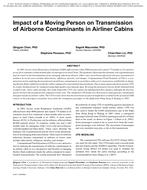Description
In 2003, Severe Acute Respiratory Syndrome (SARS) affected more than 8000 patients and caused 774 deaths in 26 countries across five continents within months after its emergence in rural China. The pandemic illustrated the dramatic role of globalization and air travel in the dissemination of an emerging infectious disease. Other cases of airborne infectious diseases transmitted in airliners in recent years include tuberculosis, influenza, measles, and mumps. Computational Fluid Dynamics (CFD) is a very attractive tool in studying the transmission of airborne contaminants in an airliner cabin as it is inexpensive and flexible in changing thermo-fluid conditions inside the cabins compared to experimental measurements. Due to many approximations used in CFD, its results should always be validated using high quality experimental data. By using the measured velocity fields obtained from a small-scale, water cabin mockup, this study found that CFD can capture the fundamental flow features although the discrepancies between the measured and computed results exist. The validated CFD model was then used to study gaseous contaminant transport inside an airliner cabin. The CFD results show that the movement of a person might have resulted in the spread of SARS viruses to the passengers seated far away from the contagious passenger in the flight from Hong Kong to Beijing in 2003.
Citation: IAQ Conference: IAQ 2010: Airborne Infection Control
Product Details
- Published:
- 2011
- Number of Pages:
- 6
- File Size:
- 1 file , 550 KB
- Product Code(s):
- D-IAQ2010-C19




